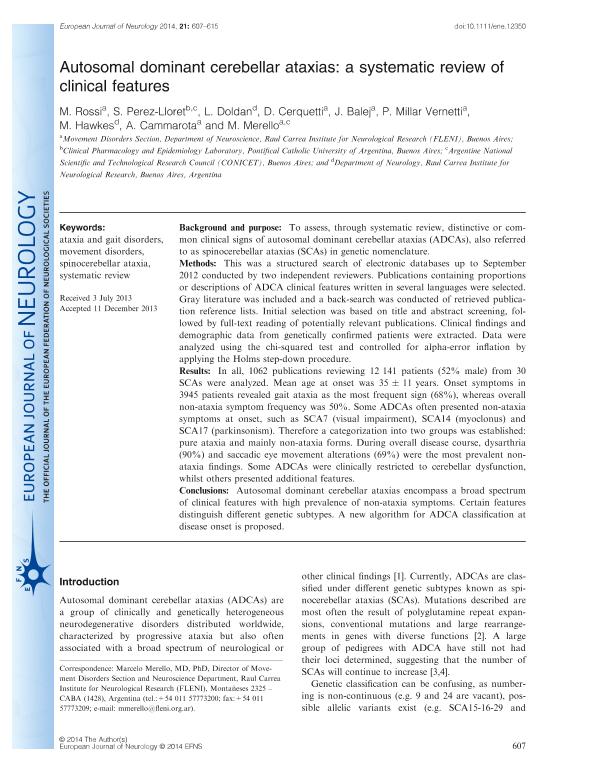Mostrar el registro sencillo del ítem
dc.contributor.author
Rossi, M.
dc.contributor.author
Pérez Lloret, Santiago

dc.contributor.author
Doldan, L.
dc.contributor.author
Cerquetti, Daniel

dc.contributor.author
Balej, J.
dc.contributor.author
Millar Vernetti, P.
dc.contributor.author
Hawkes, M.
dc.contributor.author
Cammarota, Adrian Aldo

dc.contributor.author
Merello, Marcelo Jorge

dc.date.available
2017-12-11T19:14:05Z
dc.date.issued
2014-02
dc.identifier.citation
Rossi, M.; Pérez Lloret, Santiago; Doldan, L.; Cerquetti, Daniel; Balej, J.; et al.; Autosomal dominant cerebellar ataxias: a systematic review of clinical features; Wiley; European Journal of Neurology; 21; 4; 2-2014; 607-615
dc.identifier.issn
1351-5101
dc.identifier.uri
http://hdl.handle.net/11336/30194
dc.description.abstract
BACKGROUND AND PURPOSE: To assess, through systematic review, distinctive or common clinical signs of autosomal dominant cerebellar ataxias (ADCAs), also referred to as spinocerebellar ataxias (SCAs) in genetic nomenclature.
METHODS: This was a structured search of electronic databases up to September 2012 conducted by two independent reviewers. Publications containing proportions or descriptions of ADCA clinical features written in several languages were selected. Gray literature was included and a back-search was conducted of retrieved publication reference lists. Initial selection was based on title and abstract screening, followed by full-text reading of potentially relevant publications. Clinical findings and demographic data from genetically confirmed patients were extracted. Data were analyzed using the chi-squared test and controlled for alpha-error inflation by applying the Holms step-down procedure.
RESULTS: In all, 1062 publications reviewing 12 141 patients (52% male) from 30 SCAs were analyzed. Mean age at onset was 35 ± 11 years. Onset symptoms in 3945 patients revealed gait ataxia as the most frequent sign (68%), whereas overall non-ataxia symptom frequency was 50%. Some ADCAs often presented non-ataxia symptoms at onset, such as SCA7 (visual impairment), SCA14 (myoclonus) and SCA17 (parkinsonism). Therefore a categorization into two groups was established: pure ataxia and mainly non-ataxia forms. During overall disease course, dysarthria (90%) and saccadic eye movement alterations (69%) were the most prevalent non-ataxia findings. Some ADCAs were clinically restricted to cerebellar dysfunction, whilst others presented additional features.
CONCLUSIONS: Autosomal dominant cerebellar ataxias encompass a broad spectrum of clinical features with high prevalence of non-ataxia symptoms. Certain features distinguish different genetic subtypes. A new algorithm for ADCA classification at disease onset is proposed.
dc.format
application/pdf
dc.language.iso
eng
dc.publisher
Wiley

dc.rights
info:eu-repo/semantics/openAccess
dc.rights.uri
https://creativecommons.org/licenses/by-nc-nd/2.5/ar/
dc.subject
Ataxia And Gait Disorders
dc.subject
Autosomal Dominant
dc.subject
Cerebellar
dc.subject
Movement Disorders
dc.subject
Spinocerebellar Ataxia
dc.subject
Systematic Review
dc.subject.classification
Medicina Critica y de Emergencia

dc.subject.classification
Medicina Clínica

dc.subject.classification
CIENCIAS MÉDICAS Y DE LA SALUD

dc.title
Autosomal dominant cerebellar ataxias: a systematic review of clinical features
dc.type
info:eu-repo/semantics/article
dc.type
info:ar-repo/semantics/artículo
dc.type
info:eu-repo/semantics/publishedVersion
dc.date.updated
2017-12-11T16:46:18Z
dc.identifier.eissn
1468-1331
dc.journal.volume
21
dc.journal.number
4
dc.journal.pagination
607-615
dc.journal.pais
Reino Unido

dc.journal.ciudad
Londres
dc.description.fil
Fil: Rossi, M.. Fundación para la Lucha contra las Enfermedades Neurológicas de la Infancia; Argentina
dc.description.fil
Fil: Pérez Lloret, Santiago. Pontificia Universidad Católica Argentina "Santa María de los Buenos Aires"; Argentina. Consejo Nacional de Investigaciones Científicas y Técnicas; Argentina
dc.description.fil
Fil: Doldan, L.. Fundación para la Lucha Contra las Enfermedades Neurológicas de la Infancia. Instituto de Investigaciones Neurológicas "Raúl Carrea"; Argentina
dc.description.fil
Fil: Cerquetti, Daniel. Fundación para la Lucha contra las Enfermedades Neurológicas de la Infancia; Argentina
dc.description.fil
Fil: Balej, J.. Fundación para la Lucha contra las Enfermedades Neurológicas de la Infancia; Argentina
dc.description.fil
Fil: Millar Vernetti, P.. Fundación para la Lucha contra las Enfermedades Neurológicas de la Infancia; Argentina
dc.description.fil
Fil: Hawkes, M.. Fundación para la Lucha Contra las Enfermedades Neurológicas de la Infancia. Instituto de Investigaciones Neurológicas "Raúl Carrea"; Argentina
dc.description.fil
Fil: Cammarota, Adrian Aldo. Fundación para la Lucha contra las Enfermedades Neurológicas de la Infancia; Argentina. Consejo Nacional de Investigaciones Científicas y Técnicas; Argentina
dc.description.fil
Fil: Merello, Marcelo Jorge. Fundación para la Lucha contra las Enfermedades Neurológicas de la Infancia; Argentina. Consejo Nacional de Investigaciones Científicas y Técnicas; Argentina
dc.journal.title
European Journal of Neurology

dc.relation.alternativeid
info:eu-repo/semantics/altIdentifier/url/http://onlinelibrary.wiley.com/doi/10.1111/ene.12350/abstract
dc.relation.alternativeid
info:eu-repo/semantics/altIdentifier/doi/http://dx.doi.org/10.1111/ene.12350
Archivos asociados
